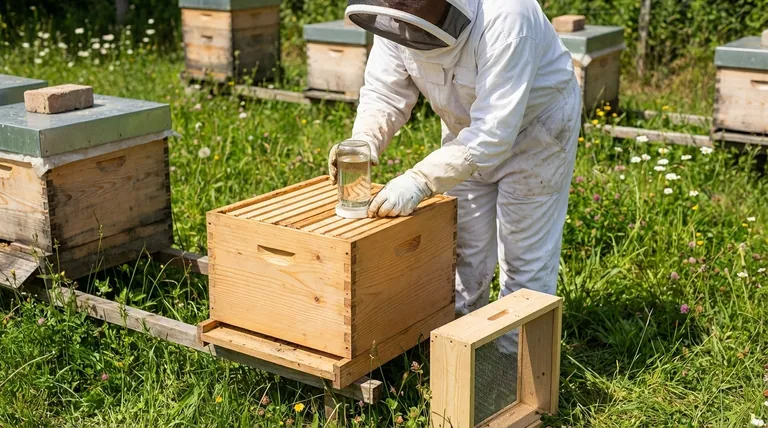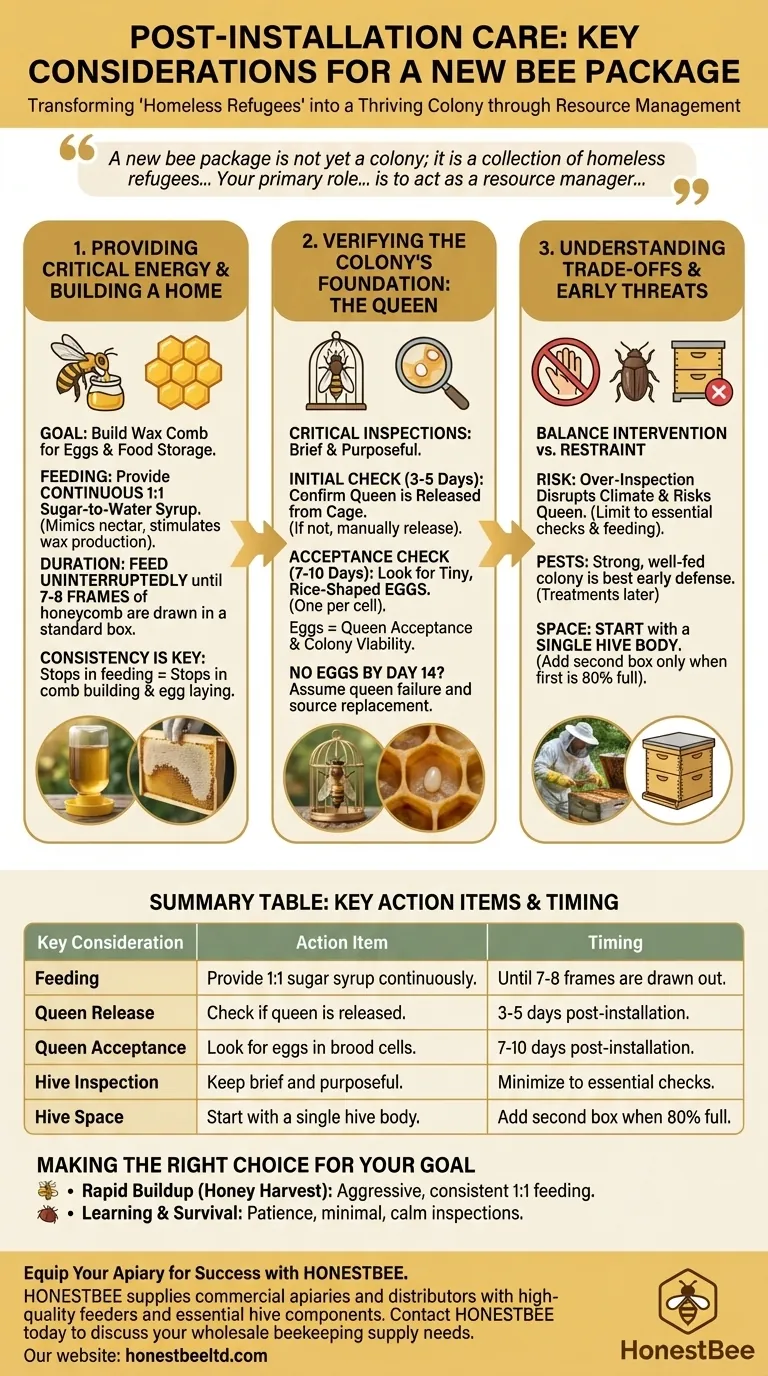The most critical actions after installing a package of bees are to provide consistent food, confirm the queen is accepted and laying, and protect the colony from early threats. A new package has no honeycomb, food stores, or developing young bees, making your initial support essential for their survival and transformation into a functioning colony.
A new bee package is not yet a colony; it is a collection of homeless refugees with a potential leader. Your primary role in the first month is to act as a resource manager, providing the consistent energy and security they need to build their home, establish a workforce, and become self-sufficient.

The Primary Goal: Building a Home from Scratch
A package of bees is working against the clock. They must immediately begin building wax comb to give the queen space to lay eggs and for the colony to store food. Your support during this phase is non-negotiable.
Providing Critical Energy with Sugar Syrup
Bees consume vast amounts of sugar to produce wax from their own bodies. Without an external food source, this process will halt.
Feed a 1:1 sugar-to-water solution (by weight or volume). This ratio closely mimics natural nectar and is the ideal stimulant for wax production.
Continue this feeding uninterruptedly until the bees have drawn out the honeycomb on at least seven to eight frames in a standard 10-frame Langstroth box.
The Importance of Consistency
A stop-and-start approach to feeding is highly detrimental. If the syrup runs out for even a day or two, the bees will halt comb construction, slowing the queen's ability to lay and delaying the development of the colony's first generation of new workers.
Verifying the Colony's Foundation: The Queen
The entire future of the hive depends on a healthy, accepted, and productive queen. Verifying her status is your most important inspection task.
The Initial Queen Check (3-5 Days Post-Installation)
Your first, brief hive inspection should confirm one thing: Has the queen been released from her cage?
If she is out of the cage, close the hive and leave them alone. If she is still inside, you should manually release her by removing the candy plug or opening the cage, then quickly close up the hive.
Confirming Queen Acceptance (7-10 Days Post-Installation)
This is the moment of truth. A week after installation, a successful queen will have started laying.
Carefully and gently remove a central frame from the hive. Look for tiny, rice-shaped eggs, one per cell, at the bottom of the hexagonal cells. Seeing eggs is the definitive sign that your queen has been accepted and your colony is viable.
What if You Don't See Eggs?
Don't panic immediately. The queen may be on a different frame, or you may have just missed them.
However, if you perform a careful check on day 10 and still see no eggs or larvae, it is a strong indicator of a problem. If there are still no signs of laying by day 14, you must assume the queen has failed and begin the process of sourcing a replacement.
Understanding the Trade-offs and Early Threats
While your support is crucial, it's also possible to harm the colony with good intentions. A successful beekeeper understands the balance between intervention and restraint.
The Risk of Over-Inspection
Every time you open the hive, you break the colony's climate control, disrupt their work, and risk accidentally injuring or "balling" the queen.
In the first month, your inspections should be brief and purposeful. Limit them to refilling the feeder and performing the essential queen checks outlined above.
Early Pest Pressure
Your new package should have a low population of Varroa mites, but it is never zero. A strong, well-fed, and rapidly growing colony is the best defense against pests like small hive beetles.
Your initial focus should be on bolstering colony strength through feeding. This allows them to manage most pest issues on their own in the beginning. Formal mite treatments are typically reserved for when the colony is more established.
The Mistake of Adding Too Much Space
Giving a small package colony too much space is a common and serious error. A large, empty cavity is difficult for the bees to warm, patrol, and defend from pests.
Always start a package in a single hive body. Do not add a second box until the first one is approximately 80% full of drawn comb, bees, and brood.
Making the Right Choice for Your Goal
Your management strategy can be fine-tuned based on your specific objectives for the first year.
- If your primary focus is rapid buildup for a honey harvest: You must be aggressive and consistent with your 1:1 feeding, never letting the feeder run dry, to drive maximum comb production.
- If your primary focus is learning and ensuring colony survival: Prioritize patience and minimal, calm inspections. Focus only on confirming the queen is laying and that the brood pattern is expanding week by week.
By providing these foundational resources, you are actively helping transform a simple box of bees into a thriving, complex, and self-sufficient superorganism.
Summary Table:
| Key Consideration | Action Item | Timing |
|---|---|---|
| Feeding | Provide 1:1 sugar syrup continuously. | Until 7-8 frames are drawn out. |
| Queen Release | Check if queen is released from cage. | 3-5 days post-installation. |
| Queen Acceptance | Look for eggs in brood cells. | 7-10 days post-installation. |
| Hive Inspection | Keep inspections brief and purposeful. | Minimize to essential checks only. |
| Hive Space | Start with a single hive body. | Add second box when first is 80% full. |
Equip Your Apiary for Success with HONESTBEE
Setting up a new package of bees is a critical time. The right supplies are essential for providing the consistent support your colony needs to build a strong foundation. HONESTBEE supplies commercial apiaries and beekeeping equipment distributors with the high-quality, durable supplies required for successful post-installation care, from reliable feeders to essential hive components.
Ensure your new colonies have the best start possible. Contact HONESTBEE today to discuss your wholesale beekeeping supply needs.
Visual Guide

Related Products
- Professional Bee Frame Wiring Tool with Integrated Tensioning System by HONESTBEE
- Nicot Queen Rearing Kit for Beekeeping and Grafting in Nicot System
- No Grafting Queen Rearing Kit: System for Royal Jelly Production and Queen Rearing
- Jenter Queen Rearing Kit Complete Set for Bee Breeding
- Retractable Chinese Queen Rearing Grafting Tools Equipment
People Also Ask
- What type of bees are better adapted to certain climatic conditions? Match Bee Strategy to Your Climate for Success
- What is the final step in wiring a frame? Secure Lasting Tension for a Durable Hive
- Why is knowing the size of a honeybee colony important throughout the year? Master Seasonal Management
- How is wire tension maintained during frame wiring? Use a Jig for Perfectly Taut Frames
- What is the advantage of a bee frame wiring jig? Drastically Speed Up Hive Preparation



















